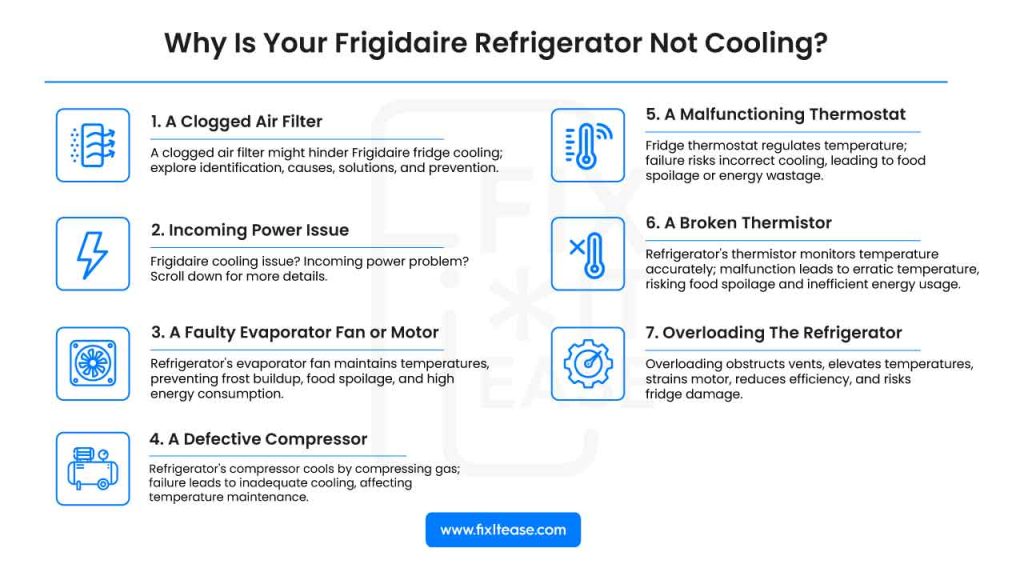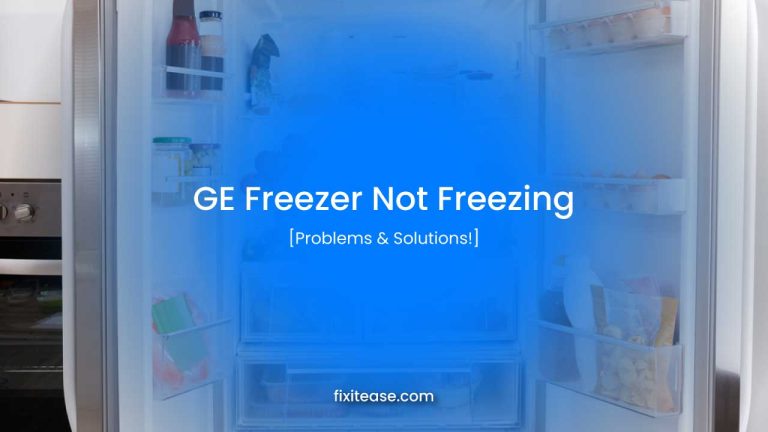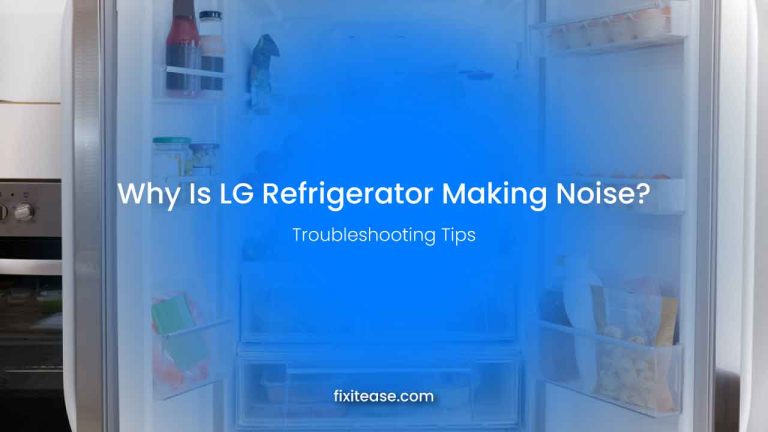7 Reasons Frigidaire Refrigerator Not Cooling – Explained!
A refrigerator that fails to cool properly can cause your food items to spoil soon. The sooner you can identify the issue and its reason, the better it is. So, what can be the reason of your Frigidaire refrigerator not cooling properly?
The reasons are many including a clogged filter, a broken thermistor, a malfunctioning thermostat, a defective compressor, incoming power issues, and so on. The fixes for each issue vary.
We won’t await you longer. Scroll down to know what exactly making your refrigerator not cooling and what you can do about it.
Why Is Your Frigidaire Refrigerator Not Cooling? Reasons and Fixes

Let’s get into the core of our discussion now!
1. A Clogged Air Filter
When your Frigidaire refrigerator isn’t cooling properly, one common reason could be a clogged air filter. This simple component plays a crucial role in maintaining the desired temperature inside your fridge. In this section, we’ll delve into what a clogged air filter means, how to identify it, what causes this issue, how to fix it, and finally, how to prevent it.
How to Identify
Apart from the cooling issue, here’s what also can be a sign that the air filter is clogged.
- Ice Production Issues: If your ice maker is no longer producing ice or the ice cubes are smaller than usual, the air filter might be to blame.
- Unpleasant Odors: A clogged filter can lead to a stale or unpleasant odor inside your fridge, indicating poor air circulation.
What Causes It
- Accumulated Debris: Over time, dust, food particles, and other debris can accumulate on the air filter, obstructing the flow of air.
- Non-Reusability: Frigidaire refrigerator air filters are not reusable. Over time, they naturally become clogged and must be replaced.
- Infrequent Cleaning: Neglecting routine maintenance, such as cleaning the air filter, can lead to clogs and reduced efficiency.
First off, you need to clean the clogged filter and examine it it works again. If not, you need to replace the air filter. Here are the details.
How to Clean It
- Unplug the refrigerator and locate the air filter. Most Frigidaire refrigerator models place the air filter under the bin in the door panel. Open the door panel and identify the air filter’s location.
- Fill a basin or sink with warm water.
- Add a small amount of mild liquid dishwashing detergent.
- Immerse the air filter in the soapy water and gently agitate it to remove dirt and debris.
- Rinse the filter thoroughly with clean, warm water to remove all soap residue.
- Allow the cleaned air filter to air-dry completely before reinserting it. Ensure it is entirely dry to prevent mold or mildew growth.
- Once the filter is dry, carefully reinsert it into the designated location in your refrigerator. Ensure it’s properly seated without excessive force to avoid bending.
How to Replace It
- Remove the Old Filter and Dispose of It: Carefully remove the old air filter. Take care not to spill any debris during this process. Since Frigidaire fridge filters are not reusable, dispose of the old filter properly. If your current filter is around 6 months old, it’s definitely time for a replacement.
- Prepare the New Filter: Unpack the new air filter and inspect it to ensure it’s in perfect condition.
- Insert the New Filter: Gently insert the new air filter into the designated location. Handle it with care to avoid bending, as this could reduce its effectiveness.
- Replug the Refrigerator: Once the new air filter is securely in place, plug your refrigerator back in.
2. Incoming Power Issue
When your Frigidaire refrigerator is not cooling, an incoming power issue might be the underlying problem. Scroll dowm for the details.
How to Identify
- Lack of Power: The refrigerator shows no signs of power, such as the interior light not turning on or the compressor and condenser fan not running.
- Other Appliances Test: To check if the power outlet is working, plug in another small appliance to see if it functions. If the test appliance works and your refrigerator doesn’t, it’s a clear sign of an incoming power problem.
What Causes It
- Loose or Inadequate Connection: If the power plug connecting your refrigerator to the electrical outlet is not firmly inserted, or if the outlet itself is not supplying power, this can cause issues.
- Fuses and Circuit Breakers: Check the outlet for any blown fuses or tripped circuit breakers. A blown fuse or a tripped circuit breaker can disrupt the power supply.
- Ground Fault Receptacle: If your refrigerator is connected to a ground fault receptacle, it might not be suitable. This type of receptacle can cause complications and lead to power supply problems.
- Wiring and Harness Issues: Broken or frayed wires, a malfunctioning control panel, or a damaged harness connecting the board to the rest of the fridge can also be causes of incoming power issues.
How to Fix It
Step 1: Check Connection and Outlet
Ensure that the plug connecting your refrigerator is securely inserted into the electrical outlet. Verify that the outlet itself is supplying power.
Step 2: Inspect Fuses and Circuit Breakers
Examine the outlet for any blown fuses or tripped circuit breakers. If you find any, replace the fuse or reset the circuit breaker as necessary.
Step 3: Check Receptacle Type
Ensure your refrigerator is connected to a regular receptacle, not a ground fault receptacle. Using the latter can cause problems. If it’s a ground fault receptacle, switch to a regular one.
Step 4: Investigate Wiring and Harness
Open the compartment covering the control box, and use a power tester to check the control panel’s functionality. If the control panel is not getting enough voltage, you may need to replace it. Inspect wires for damage and replace any broken or frayed ones. Also, check the harness that connects the board to the rest of the fridge, and test its functionality using a power tester.
3. A Faulty Evaporator Fan or Motor
The evaporator fan in a refrigerator circulates cold air to maintain even temperatures, preventing frost buildup and preserving food freshness. If it fails, inadequate cooling, frost accumulation, uneven temperatures, and increased energy consumption can occur, potentially leading to food spoilage and higher utility bills.
How to Identify
- Inadequate Cooling: If you notice that your refrigerator is not cooling properly, and your food is not as cold as it should be, this may indicate an issue with the evaporator fan or motor.
- Unusual Noises: A noisy or squealing sound, especially when you open the freezer door, can suggest a problem with the evaporator fan. It may be struggling to function.
- Frost Buildup: If you find excessive frost or ice on the evaporator coils, this may signal that the evaporator fan is not circulating air properly, leading to cooling problems.
What Causes It
- Frost Buildup: Excessive frost accumulation on the evaporator coils can hinder the operation of the fan, leading to its failure.
- Age and Wear: Over time, the motor of the evaporator fan can wear out due to continuous use, eventually causing it to fail.
How to Fix It
Step 1: Check for Frost Buildup
Inspect the evaporator coils for excessive frost or ice. If you find a buildup, it might be blocking the fan’s operation. In this case, unplug the refrigerator and let it thaw for 24 to 48 hours, and then plug it back in.
Step 2: Testing with a Multimeter
To determine if the evaporator fan motor is defective, use a multimeter to test it for continuity. If there is no continuity, the motor needs to be replaced.
Step 3: Replacement
If the motor is indeed faulty, consider replacing it with a new one. You can obtain the replacement motor from the refrigerator’s manufacturer.
Step 4: Professional Help
If you suspect the issue with the evaporator fan or motor is beyond your expertise, it’s advisable to seek professional assistance. Attempting to fix it yourself could void your warranty.
4. A Defective Compressor
The compressor in a refrigerator is responsible for compressing refrigerant gas, raising its temperature, and then allowing it to cool down rapidly. It enables the refrigerator to maintain a cold interior. If the compressor fails, the refrigerator won’t be able to maintain a cold temperature which can lead to inadequate cooling.
How to Identify
- Unusual Noise: If your refrigerator makes a loud noise when it’s turned on, it could be a sign of a compressor issue.
- Extended Cooling Time: If your fridge takes longer than usual to cool down or isn’t reaching the desired temperature, this may indicate a compressor problem.
- Ice Buildup: Excessive ice buildup inside the fridge could be a result of a malfunctioning compressor.
What Causes It
- Age and Wear: Over time, the compressor may wear out, leading to a decline in its performance.
- Manufacturing Defect: In some cases, a new fridge may have a compressor with a manufacturing defect.
- Overloading: Overloading the fridge with too much food can put extra stress on the compressor, leading to failure.
- Poor Maintenance: Neglecting routine maintenance, such as cleaning the condenser coils, can cause the compressor to fail.
How to Fix a Defective Compressor:
If the compressor is indeed the problem, it’s a job for a qualified refrigerator technician. Replacing a compressor can be expensive, so it’s advisable to get multiple repair estimates before proceeding. In some cases, especially if the fridge is relatively new, it might be more cost-effective to replace the fridge instead of just the compressor.
5. A Malfunctioning Thermostat
A thermostat in a refrigerator regulates the internal temperature by turning the compressor on and off as needed to maintain the desired coldness. If it fails, the fridge may become too warm or too cold, risking food spoilage or energy wastage.
How to Identify
Check the thermostat knob or dial inside the refrigerator. Ensure it turns smoothly and is set within the proper temperature range, typically below 40°F (4°C) and above 35°F (2°C). If the knob is stuck or if you don’t hear a clicking sound as you adjust the temperature, it could be a sign of thermostat malfunction.
What Causes It
A malfunctioning thermostat may be caused by a mechanical issue that prevents it from adjusting the temperature settings. This can be due to a frozen or stuck thermostat knob or internal components that are not functioning correctly.
How to Fix It
- First, ensure the power is turned off to the refrigerator.
- Locate the thermostat, which is often a round knob inside the fridge.
- Attempt to turn the thermostat knob to the lowest setting (OFF) and listen for a clicking sound. A click indicates proper thermostat operation.
- If no click is heard, you may need to replace the thermostat. This is a relatively simple DIY repair.
- Unplug the old thermostat and install a new one. Make sure the power is off while you perform this replacement.
6. A Broken Thermistor
A thermistor in a refrigerator is a sensor that monitors temperature. It changes its electrical resistance with temperature variations, allowing it to measure the fridge’s internal temperature accurately.
If a thermistor is broken, it can cause erratic temperature control. The refrigerator may become too warm or too cold, leading to food spoilage or inefficient energy usage.
How to Identify
You can test the thermistor’s functionality with a multimeter. Ensure the temperature is 46 degrees Fahrenheit (7 degrees Celsius) or colder. Place the thermistor tip into a cup of ice water and check if the reading falls between 10—15kΩ. If it’s outside this range, you likely have a defective temperature sensor.
What Causes It
- Over time, these sensitive temperature sensors may degrade or suffer damage, leading to inaccurate temperature readings.
- Dust and dirt accumulation around the thermistor can also disrupt its function, as it relies on unobstructed airflow for accurate temperature monitoring.
- Additionally, poor ventilation inside the fridge compartment can cause the thermistor to overheat, further impairing its performance.
How to Fix It
To determine whether your thermistor is damaged, you need to test it with a multimeter.
- To test a thermistor with a multimeter, start by disconnecting the refrigerator’s power.
- Locate the thermistor, usually near the cooling coils, and remove it from its connector. Set your multimeter to the resistance or ohms setting.
- Place one multimeter probe on each thermistor wire. The resistance should change as the temperature changes. If the resistance remains constant, the thermistor is likely faulty and needs replacement.
This simple test helps determine if the thermistor is accurately sensing temperature, ensuring proper refrigerator cooling.
7. Overloading The Refrigerator
Overloading the refrigerator obstructs the vents and disrupts airflow within the refrigerator. This can lead to elevated temperatures inside the refrigerator and freezer, causing the motor to work harder, negatively impacting energy efficiency, and potentially damaging the fridge.
How Overloading Impacts Cooling:
When the refrigerator is overloaded, it obstructs the vents and hinders the free circulation of cold air, leading to uneven cooling. The evaporator fan’s ability to maintain the desired temperature is compromised, and the refrigerator has to work harder to keep things cool.
This not only reduces cooling efficiency but also increases energy consumption. Overloading can lead to frost buildup in the freezer, spoilage of food due to poor air circulation, and decreased lifespan of the appliance.
What You Can Do About It
- Properly Load Your Fridge: Avoid overloading your refrigerator and freezer. Leave sufficient space for air to circulate by not filling the compartments to the brim.
- Unblock Vents: Check for any obstructions in the vents, which can disrupt airflow. Make sure the vents in both the fridge and freezer are clear of any food items.
- Ensure Clean Coils: Ensure that the coils behind the refrigerator are free from dust and debris. Clean them periodically to improve cooling efficiency.
- Prevent Frost Buildup: If frost accumulates on the back wall of the freezer, remove food, discard any spoiled items, and defrost the freezer as needed.
How to Prevent The Issue in The Future
Here are a few preventative tips for you that will help you avoid the issue in the future.
- Avoid overloading your fridge, as overcrowding can block airflow and strain the cooling system, making it less efficient.
- Regularly inspect and clear vents in both the fridge and freezer compartments to ensure air can circulate freely, maintaining even cooling.
- Set the thermostat to the manufacturer’s recommended temperatures (usually around 37°F or 3°C for the fridge and 0°F or -18°C for the freezer) to maintain optimal cooling performance.
- Ensure that the door seals are intact and seal tightly when the doors are closed. Damaged or worn seals can let warm air in, causing cooling issues.
- If your fridge has a manual defrost setting, make sure to defrost the freezer as needed to prevent excessive frost buildup, which can reduce cooling efficiency.
- Schedule routine maintenance checks by a professional technician to identify and address potential cooling problems before they become severe, extending the life of your fridge.
FAQs
Why is my refrigerator working but not cooling?
If your refrigerator is running but not cooling properly, several issues might be at play. First, check if the thermostat settings are correct. Next, ensure the condenser coils are clean, as dust buildup can hinder heat dissipation.
Damaged door seals can also let warm air in, impacting cooling. If the fridge is overcrowded, poor airflow could be the culprit. Additionally, a malfunctioning compressor, condenser fan, or evaporator fan might be the cause. It’s best to have a professional technician diagnose and fix the problem for you.
How do I reset my refrigerator compressor?
Resetting a refrigerator compressor is typically unnecessary, but if you must, unplug your fridge for at least five minutes. Then, plug it back in and set the temperature to the desired level.
However, be cautious as manually resetting the compressor can sometimes lead to further issues. If your fridge isn’t cooling properly, it’s best to consult a professional technician to diagnose and fix the problem safely.
Is a fridge colder on 1 or 5?
In most refrigerator temperature settings, the higher the number, the colder the fridge. So, setting it to 5 usually means it’s the coldest.
The specific temperature associated with each number can vary from one fridge to another, but generally, lower numbers mean less cooling, and higher numbers mean more cooling. However, it’s a good practice to consult your refrigerator’s manual to understand its temperature settings precisely, as some models may differ.
Last Words
Hopefully, now you’ve found out why your Frigidaire refrigerator isn’t cooling.
When experiencing this issue, you should first check for power, thermostat settings, and potential blockages. If those are not the culprits, a malfunctioning compressor, evaporator fan, or thermistor may be to blame.
Remember, diagnosing and fixing these issues may sometimes require professional assistance, but with some basic troubleshooting and preventative measures, you can keep your fridge running smoothly.







